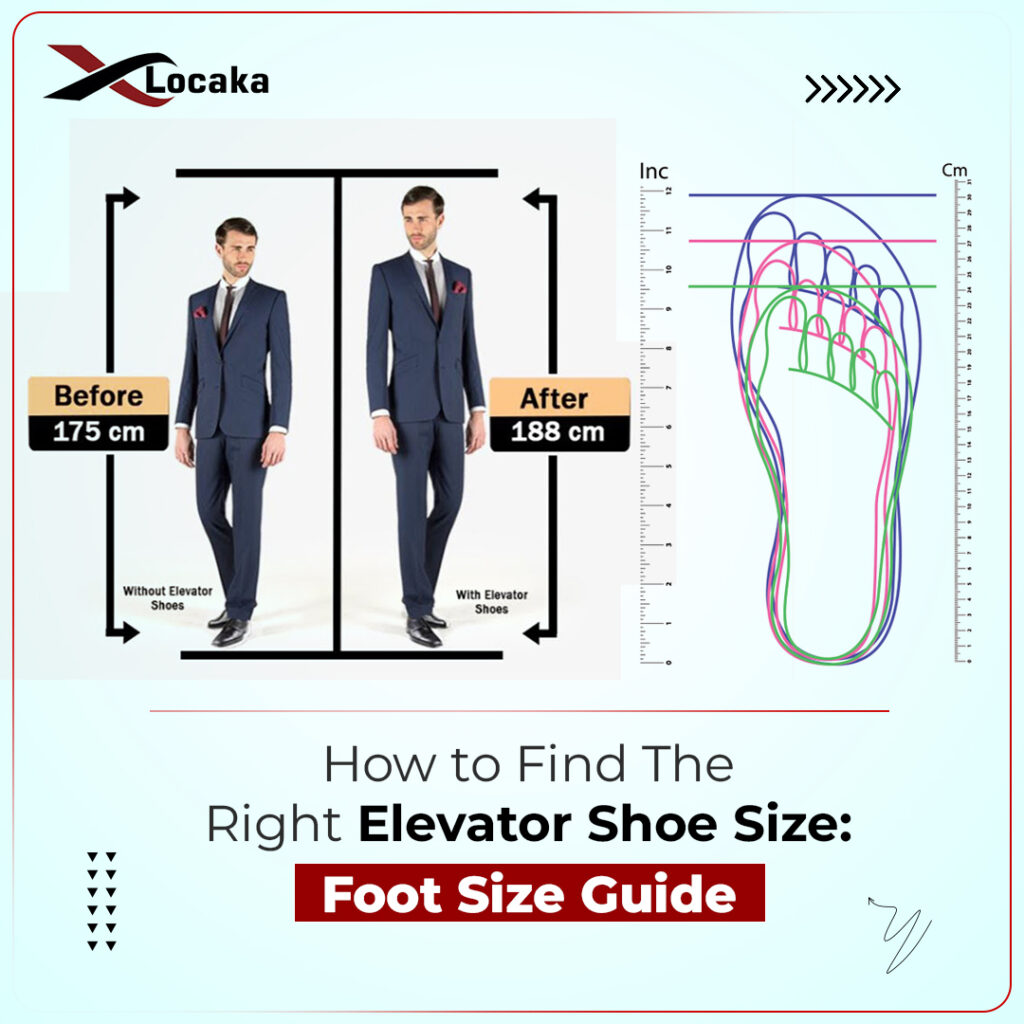How to Find The Right Elevator Shoe Size: Foot Size Guide

Comfortable elevator shoes play a significant role in foot and body health. Buying shoes in the correct size ensures a comfortable fit, especially in case of elevator shoes for men & women. If you want to know which shoe length, width, or type is right for you, this is the place.
Research has found that 3 out of every 4 adults still wear either bigger or smaller shoes than their correct foot size. This can increase the risk of foot, leg, ankle, and lower back pain and various other problems.
When shoes do not fit properly, it can cause bunions, calluses, hammertoes, plantar fasciitis, stress fractures, and more. Therefore, it’s essential to choose the right shoe brand but also the right size of shoes so that you feel comfortable in every step.
In this elevator shoe sizes guide, you get a clear idea of why the correct shoe size is essential, what is shoe size conversion chart for the US, UK, and EURO, how to measure and find the right elevator shoe size, and more…
Why is the size of the shoes important?
When your shoes fit your feet properly and are not too tight or not too loose, they provide a steady platform for your foot to support your body weight. Wearing a height increasing shoe that is too big will make us walk in a dysfunctional and unnatural way.
But if you wear a shoe that is too tight, it will hurt your feet and, most likely, lead to blisters, bunions, and calluses. Both these scenarios can lead to serious foot problems.
Consider buying elevator shoes for women and men from top shoe brands like Locaka, where you get a variety of shoe sizes such as elevator shoes with 13cm (5.12 Inch), 12cm (4.72 Inch), 10cm (3.94 Inch), 9cm (3.54 Inch), 7cm (2.76 Inch), 6cm (2.36 Inch), 5cm (2.17 Inch) and more.
Shoe Size Conversion Chart For Men & Women» US | UK | EURO
Shoe size systems in the US, UK, and EU are different, so it is essential to know your size in each region to find the right fit when shopping for shoes. To be sure you are wearing the proper shoe size when buying new shoes, you have to measure your foot. The size chart is just a reference; your feet’s length and width decide the size.
When placing your order, let our shoe expert know so we can advise you about choosing the right fit size to fit you well and wear them comfortably. In addition, if your feet are fat, we advise you to choose one bigger size.
(A) Shoe Size Conversion Chart For Men
(B) Shoe Size Conversion Chart For Women
How to Find Your Elevator Shoe Size
At one time or another, we have all tried to wear shoes that were too small or too big. Knowing your correct shoe size is necessary for buying shoes. Finding your shoe size before you buy saves you time and helps you avoid buying a pair that doesn’t fit and having to return them. Follow these 11 tips to help you choose the right shoes:
1. Tracing of your foot: Take a tracing of your foot. Place any shoe on top of the tracing. If the shoe is shorter than the tracing, don’t even try it on.
2. Wear socks: Wear the same type of socks to the store you intend to wear with the shoes.
3. Measure both of your feet correctly: Have a salesperson near you measure both feet — get measured every time you buy new pair of elevator shoes. Feet change with age, often growing wider & larger. Choose a size that fits well with the larger foot if one of your feet is bigger than the other.
4. Stand in the shoes: Press gently on the shoe top to ensure a half-inch of space between your longest toe and the end. This provides enough space for your foot to press forward as you walk.
5. Watch your walk: Walk around in the shoes to determine how they feel.
6. Feel the material: Feel the inside of the shoes to see if they have any tags, seams, or other material that might irritate your foot.
7. Check your comfort level: Trust your comfort level rather than the shoe size in the description, as sizes vary between manufacturers. You’re the real judge, no matter how comfortable an advertiser claims those shoes are.
8. Pay attention to width and length: Ask if a shoe comes in a wider size if the ball of your foot feels bound. This issue won’t resolve by purchasing shoes that are a half-size larger but not any wider.
9. Examine the soles: Do they have the toughness to guard against sharp objects? Do they offer any cushions? As you browse the shoe showroom, pay attention to how they feel. Try walking on concrete and carpet to understand the shoe’s comfort.
10. Check return & exchange policy: Choose a brand that offers the best return and exchange policy with a 30-day, 100% money-back guarantee when buying elevator shoes for men and women online.
11. Choose the right shoe brand: Select top shoe brands in USA where you get a variety of shoe sizes, such as elevator shoes with 12cm (4.72 Inch), 13cm (5.12 Inch), 10cm (3.94 Inch), 9cm (3.54 Inch), 7cm (2.76 Inch), 6cm (2.36 Inch), 5cm (2.17 Inch) and more.
The Bottom Line
To be sure you are wearing the proper shoe size when buying new shoes, you have to measure your foot. When you walk in shoes that don’t fit properly, you are not only affecting your feet; you are also affecting other parts of your body like your neck, back, and knees.
Your toes should be able to move freely, and you must match your shoes to the activity you will be doing. Be careful of very old shoes because when shoes are worn out, they lose their ability to absorb shock, which can also lead to injuries and pain. Select top shoe brands like Locaka, where you get various sizes of shoes, such as elevator shoes with 10cm (3.94 Inch), 13cm (5.12 Inch), 12cm (4.72 Inch), 9cm (3.54 Inch), 7cm (2.76 Inch), 6cm (2.36 Inch), 5cm (2.17 Inch) and more.


